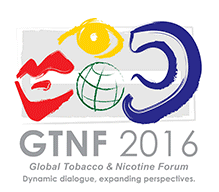
Informative, well-attended and transparent, the 2016 GTNF set new standards for tobacco-related events.
By Taco Tuinstra
In the eight years since its creation, the Global Tobacco & Nicotine Forum (GTNF) has gone from strength to strength, with each event setting new benchmarks in terms of participation and discussion. True to form, the most recent GTNF, held in Brussels, Sept. 27–29, again raised the bar. Not only did the event attract speakers of an unprecedented caliber; it also broke ground in terms of transparency.
Unlike previous GTNFs, the 2016 gathering took place without the Chatham House Rule, allowing participants to use and attribute the received information. In addition, the forum was open to representatives of the mainstream press (also see sidebar), providing a stark contrast with the Conference of the Parties (COP) to the World Health Organization’s (WHO) Framework Convention on Tobacco Control (FCTC). Over the years, the COP has repeatedly drawn criticism for banning reporters and other observers from its proceedings.
The 2016 GNTF also stood out because of the participation of prominent public health advocates, many of whom braved criticism from within their ranks for attending a tobacco event. Prior to the forum, some of the health representatives received a warning letter from the Campaign for Tobacco-Free Kids, urging them to stay home. “We hope your participation in the GTNF 2016 program was just a misunderstanding, which will soon be rectified,” the letter said.
Reflecting the seismic changes taking place in the tobacco industry, the conference’s theme was “Managing transformation—a sustainable future of tobacco and nicotine.” In his opening address, GTNF advisory board chairman Mark Kehaya thanked the health professionals for their involvement and stressed the importance of engagement. While regulators understandably seek to protect policymaking from vested interest, he said, this is no justification for industry exclusion. “We have valuable expertise to contribute.”
In recent years, noted Kehaya, the tobacco and vapor industries have developed revolutionary new products to reduce health risks while satisfying the consumer. Such private-sector initiatives have arguably done more to enhance public health than any state intervention. Health authorities in the United Kingdom have even credited e-cigarettes with an unprecedented decline in smoking. “The government got out of the way and did not spend a single penny,” said Kehaya, who is also chairman of Alliance One International and Madvapes.
Not every country has been as pragmatic, however. In the United States, for example, the Food and Drug Administration (FDA), has consistently ignored studies supporting e-cigarettes. The EU has implemented strict rules, and other governments have banned vapor products altogether.
GTNF host Patrick Basham, who heads the fiercely pro-market Democracy Institute, raised eyebrows by praising Russia’s Communist Party. While the U.S. Democratic Party banned e-cigarettes at its Philadelphia convention, he explained, the Communists have enthusiastically embraced the new product category. One of their campaigns features an image of Stalin holding a personal vaporizer instead of his trademark pipe, accompanied by the slogan, “Comrades, transform yourself!”
Presciently, Basham cautioned that vapers might “get their revenge” at the U.S. election, as a disproportionate share of them live in so-called swing states. “Hypothetically, vapers could decide the election,” he said.
Basham then drew attention to the fact that, after a period of progress, free speech was in retreat worldwide, with governments increasingly prosecuting those expressing contrarian viewpoints. Placed into that context, he argued, events such as the GTNF are even more important. “The best defense against bad policy is free speech,” he said.
Reassuring his host, the first keynote speaker, Iuliu Winkler, expressed his commitment to sound lawmaking. “We must legislate wisely and manage conflicting interests,” said Winkler, who is vice chair of the European Parliament’s Committee on International Trade.
In a passionate presentation, Ian Paisley, member of Parliament for North Antrim, U.K., described what happens when politicians discard such advice.
Paisley’s electoral district is home to the U.K.’s last remaining cigarette factory, JTI’s plant in Lisnafillan. Since its opening in 1941, the facility has employed thousands of workers and contributed millions of pounds in tax revenues. Due to various reasons, including regulatory pressures, the factory will close in 2017.
Denouncing “regulation for the sake of regulation,” Paisley detected a deliberate failure among lawmakers to understand the consequences of their actions. Recent anti-tobacco legislation, he maintained, had been about destroying the factory rather than promoting health. “None of the measures will stop even one person from smoking,” said Paisley.
But politicians ignore voters at their peril. While most of Northern Ireland voted to remain in the EU during the recent referendum, North Antrim voted to leave—even though it has received “bucket-loads” of EU subsidies. “People felt that Brussels’ edicts had taken away their factory,” said Paisley.
Brexit, he ventured, was a response to micromanaging by Eurocrats. According to Paisley, the lofty ambitions that prevailed in the EU’s early days have been replaced by petty rule-making. “Instead of promoting world peace, the EU is now arguing about the font size of health warnings,” he lamented.
Lofty goals also featured prominently in the presentation of the following GTNF speaker, Alan McGill of PricewaterhouseCoopers, who focused on sustainability. But unlike the EU leaders, who seem to have lost sight of their founding ideals, McGill had given careful thought on how to keep such objectives front and center.
He encouraged his listeners to reimagine their businesses in the face of societal, environmental and demographic challenges, urging them to move from a shareholders’ mentality to a stakeholders’ mentality.
And while sustainability is sometimes dismissed as a “soft” goal, McGill insisted it can translate into hard cash. “Green can be profitable,” he said, citing efforts to reduce the use of raw materials or to transform waste into a profit center, like when Puma started using rubber from discarded tires to manufacture shoe soles.
Giovanni Giordano, British American Tobacco’s (BAT) group director of human resources, focused on the industry’s most valuable asset—its people. The negative public perception of their business means tobacco companies must work harder than other firms to attract the best and brightest.
Giordano explained that, when first approached, 25 percent of potential recruits rejected BAT out of hand, 25 percent had no problem with tobacco and 50 percent were “reluctantly open-minded—they wished the call had come from another industry.”
But once BAT’s recruiters dispel the myths about tobacco and communicate the company’s values, an amazing conversation takes places. According to Giordano, BAT ends up recruiting 95 percent of the candidates in the reluctantly open-minded group.
Marc Firestone, senior vice president and general counsel at Philip Morris International (PMI), illustrated the challenge of establishing a regulatory framework for tobacco by quoting from an imaginary conversation at the WHO.
“The answer,” he said, “is C10-H14-N2.”
By citing the molecular formula for nicotine, Firestone demonstrated that some things are a matter of fact, not dogma. To improve decision-making, he said, stakeholders need to move beyond preaching and counter-preaching. Polarization should be replaced by pragmatism.
A regulatory framework, in Firestone’s view, must be fit for purpose. In this context, he also cautioned against “the risk of risk aversion.” Tools to manage uncertainty should not block innovation.
“The goal is to avoid a drug-adverse event,” said Firestone. “Regulators should minimize unintended consequences and reduce barriers to progress.”
Too often, unfortunately, lawmakers fail to fully consider the impact of their proposals. Recent suggestions to mandate severe nicotine reductions in tobacco products could well yield the unintended consequences Firestone warned against.
Jack Henningfield, vice president of research and health policy at Pinney Associates, led a panel discussion about the promise and the peril of nicotine reduction strategy.
Having lain dormant for some time, the concept of nicotine reduction has recently resurfaced. While the FDA is by law prohibited from reducing nicotine contents to zero, it has authority to reduce nicotine to nonaddictive levels. Furthermore, the 2014 U.S. Surgeon General’s Report and a 2015 WHO TobReg advisory note discussed a regulatory approach that would require the reduction of cigarette nicotine content to a level that could not readily cause or sustain dependence.
Most speakers agreed that mandating nicotine reduction is a bad idea. “Forced change works only if there are viable alternatives,” said David Sweanor, adjunct professor of law at the University of Ottawa.
A better approach toward harm reduction, he said, would be to incentivize the market, through lighter taxation on less harmful products, for example.
“If there are viable alternatives, you won’t need the coercion.”
This viewpoint was echoed by Rolf Lutz, director of product policy at PMI. “Nicotine is the primary addictive substance, but most toxins result from burning tobacco,” he said. “We must move people to noncombustible products.”
Clive Bates of The Counterfactual dismissed nicotine reduction as “the worst strategy ever.”
“Let’s face it: Nobody will use such cigarettes,” he said. “Smokers will divert to counterfeits, thus subverting the intentions.”
Day 2
The second day of the GTNF followed the same format as the first, featuring a plenary session focusing on the industry’s grand themes in the morning, followed by breakout sessions on more narrowly defined topics in the afternoon. (To read about individual breakout sessions, please visit www.gtnf-2016.com.)
Carolyn Hanigan, president of the recently established RAI Innovations Co., said technological progress presented a once-in-a-generation opportunity. But even as vapor products held much potential, she said the category also faced obstacles, such as a lack of epidemiological data, negative press coverage and poor product integrity. Two-thirds of Americans believe vaping is as harmful as smoking, she noted, while exploding batteries continue to generate negative headlines.
According to Hanigan, the proper way to deal with such challenges is to obtain clarity regarding the relative risks of vaping and to establish product standards.
Technology, too, must further improve, as too many consumers are returning to smoking, unsatisfied with the current vaping experience. “We need game-changing innovation,” said Hanigan. “That’s RAI’s mission—to help realize the potential.”
Francis Crawley, executive director of Good Clinical Practice, highlighted another obstacle: the increasing difficulty tobacco companies are facing in getting their research published. In recent years, prominent publications, such as The BMJ, have stopped accepting papers from the tobacco industry, arguing that tobacco companies profit from nicotine addiction and have in the past used research to produce ignorance.
Crawley believes such policies are wrongheaded. “There is an obligation to review all science,” he said. Research, he added, should be judged on its quality rather than its source. What’s more, organizations such as the WHO and the EU require tobacco companies to conduct research. “You cannot oblige people to do science and then prohibit them from publishing their findings,” said Crawley.
Peer review can be an effective way of exposing bad science, and Sinclair Davidson, professor of institutional economics at RMIT University in Melbourne, Australia, had a field day debunking a government study suggesting that Australia’s plain packaging experiment had been successful in reducing smoking prevalence.
By cherry-picking the data, said Davidson, the study’s authors had created an optical illusion of an above-trend decline in smoking following the introduction of generic packs, which he described as “medical pornography.” In reality, according to Davidson, the most significant change in smoking behavior has been a significant increase in sales of deep-discount cigarettes at the expense of more pricey varieties.
The morning ended with a panel discussion titled “Advancing public health with new products and regulatory frameworks.” Moderator Henningfield said the recent alignment between health and commercial interests presented considerable opportunities, but added that success would depend on effective regulatory frameworks.
George Adams, a cardiologist for Rex Healthcare at the University of North Carolina, showed a video explaining vascular disease, which he compared to a plumbing blockage.
While the medical guidelines promote smoking abstinence, Adams noted that traditional cessation therapies are successful only for highly motivated people. From experience in his practice, he believes that e-cigarettes are more effective in weaning people from combustibles. “I need you to help me help them by developing effective devices,” he pleaded with his audience. “Give me something to save lives.”
Germana Barba, director of corporate affairs and reduced-risk products at PMI, which has had considerable success with its new iQOS heat-not-burn technology, said her company intended to do just that. PMI’s mission, she maintained, was to convince every smoker to switch to less harmful products.
However, because the new products are vastly different, they need an appropriate regulatory framework. “We cannot simply extend cigarette regulations,” said Barba. Health warnings should reflect the different nature of the new products, she added, and governments should allow companies to communicate their innovations.
Bates argued for a hands-off attitude toward new products. “Doing nothing has been the approach until recently—and it has worked remarkably well,” he said, referring to the historical low smoking rates in the U.S. The FDA’s deeming regulations, he noted, clearly don’t meet the do-nothing criteria.
Bates also cautioned against unintended consequences. “Banning e-cigarettes ads may seem reasonable, but it protects combustibles,” he said.
Nicotine dependence expert Karl Fagerstrom said the concept of harm reduction need not be proved to regulators, because a successful example already exists. The legal availability and social acceptance of snus in Sweden has contributed to a male smoking rate of only 7.9 percent—the “endgame” level targeted by some health advocates.
Mike Ogden, vice president of scientific and regulatory affairs for RAI Services, said regulators and the industry should work together to create a framework that allows for innovation and common-sense regulations. New products, he said, ought to balance harm reduction with customer satisfaction. “A zero-risk product has zero health benefits if nobody uses it,” he said.
Summarizing his takeaway from both public health panels, Henningfield said, “The race to transform the market and migrate smokers from cigarettes to less harmful noncombustible products should be embraced by both proponents and opponents of nicotine reduction because it is essential to enable a nicotine-reduction policy, but it could also reduce the apparent need for such a policy and tolerance for the potential perils of the policy.”
The panel participants agreed that moving consumers away from combustibles would require a broad selection of products to suit diverse preferences, a concept that neatly aligned with the topic of the GTNF’s final presentation.
Like last year, the much-anticipated closing keynote was delivered by David O’Reilly, BAT’s group scientific and R&D director and chairman emeritus of the GTNF advisory board.
O’Reilly focused on the fragmentation of the market. Stimulated by social media, today’s consumers are increasingly looking for unique sensory experiences; they expect choice. This trend is not limited to nicotine products but extends to many other categories. Consumers can now select from a bewildering array of coffees and breakfast cereals, for example. The U.S. beer market—traditionally dominated by large conglomerates—has recently experienced an explosion in the number of microbreweries.
For the tobacco business, the 20th century was unique in that it was dominated by a single product, the combustible cigarette—but that is changing rapidly. O’Reilly reminded his audience that tobacco is the only fast-moving consumer goods business where most users want to stop using its main product. Price hikes, smoking restrictions and social stigmatization have only added to the pressure to abandon cigarettes.
Until recently, that did not matter for the industry because nicotine-craving smokers had nowhere else to go. But with the rise of next-generation products, users have started switching, and tobacco companies are forced to adapt. “We must change with the consumer, not vice versa,” said O’Reilly.
To win in the new nicotine space, companies should develop a solid understanding of consumer switching, while gaining sharp insights into next-generation products. O’Reilly went on to describe the platforms that BAT is developing to meet the changing consumer demands—Vype (vapor), Glo (heated-tobacco), iFuse (hybrid) and Voke (licensed medicinal product).
Tobacco companies have a choice, he said, returning to the conference’s “Managing transformation” theme. “We allow disruption to happen to us, or we do it ourselves.”













